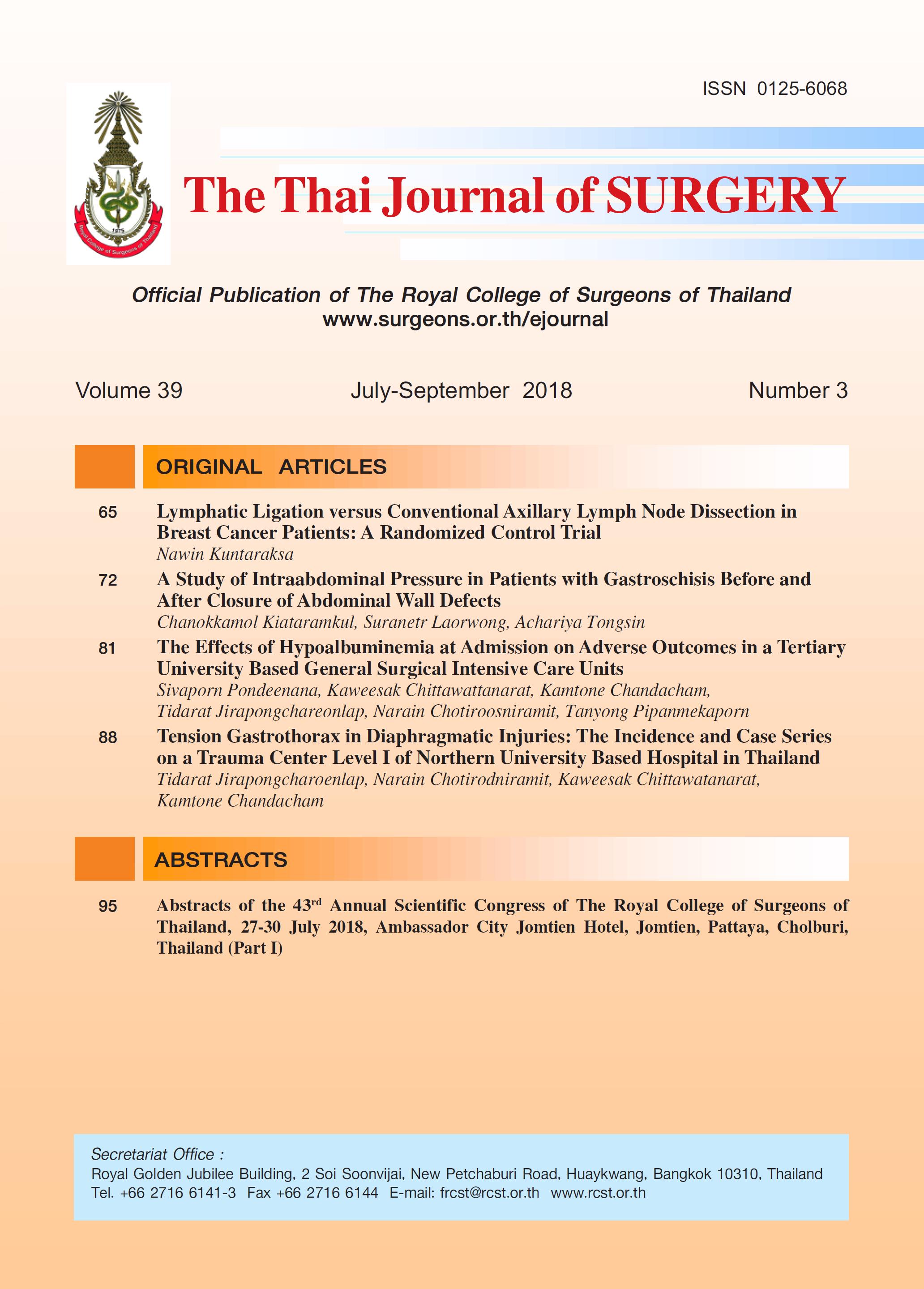Lymphatic Ligation versus Conventional Axillary Lymph Node Dissection in Breast Cancer Patients: A Randomized Control Trial
Keywords:
Breast cancer, axillary dissection, seroma, lymphatic ligationAbstract
Background and Objective: Seroma was a common complication of breast cancer surgery. It is a source of significant morbidity that led to delay adjuvant treatment. The primary objective was to evaluate seroma formation in a comparison between the lymphatic ligation technique and conventional axillary lymph node dissection.The secondary objective was to evaluate the factors affecting seroma formation.
Materials and Methods: A randomized control trial was conducted between January 2014 and November 2017.Sixty eight consecutive patients underwent mastectomy with axillary lymph node dissection by one experiencedsurgeon. The patients were randomly assigned to Group1 (lymphatic ligation) (n=34) and Group 2 (conventional surgery) (n=35).
Results: 18 patients developed seroma (26.09%) with 8 (23.53%) patients were in the lymphatic ligation group and 10(28.57%) patients were in the conventional group. No statistical significance was found in seroma formation (p = 0.633), drain duration (p =0.238) or total drain volume (p = 0.330) between the two groups. Lymphatic ligation was statistically and significantly correlated with longer operative time (p = 0.002). Age, BMI, total drain volume and drain dislodgement were significant factors influencing seroma formation (p = 0.005, p = 0.002, p = 0.008, p = 0.015, respectively). Multivariate analysis showed age and BMI were significant factors influencing seroma formation (p = 0.008, p = 0.025, respectively).
Conclusion: The lymphatic ligation technique could not reduce the incidence of seroma formation. Age, BMI were the factors influencing seroma formation in the patients undergoing mastectomy with axillary lymph node dissection.
References
2. Sampathraju S, Rodrigues G. Seroma formation after mastectomy: Pathogenesis and Prevention. Indian J Surg Oncol 2010;1:328-33.
3. van Bemmel AJM, van de Velde CJH, Schmitz RF, Liefers GJ. Prevention of seroma formation after axillary dissection in breast cancer: A systematic review. Eur J Surg Oncol 2011; 37:829-35.
4. Khan S, Khan S, Chawla T, Murtaza G. Harmonic scalpel versus electrocautery dissection in modified radical mastectomy: A randomized controlled trial. Ann Surg Oncol 2014;21:808-14.
5. Chand N, Aertssen AMG, Royle GT. Axillary “Exclusion” A successful technique for reducing seroma formation after mastectomy and axillary dissection. Advances in Breast Cancer Research 2013:1-6.
6. Sakkary MA. The value of mastectomy flap fixation in reducing fluid drainage and seroma formation in breast cancer patients. World J Surg Oncol 2012;10:8.
7. El Nakeeb A. Influence of fibrin glue on seroma formation after modified radical mastectomy: A prospective randomized study. Breast J 2009;15:671-2.
8. Gong Y, Xu J, Shao J, Cheng H, Wu X, Zhao D, et al. Prevention of seroma formation after mastectomy and axillary dissection by lymph vessel ligation and dead space closure: a randomized trial. Am J Surg 2010;200(3):352-6.
9. Aitken DR, Minton JP. Complications associated with mastectomy. Surg Clin North Am 1983;63:1331-52.
10. Stanczyk M, Grala B, Zwierowicz T, Maruszynski M. Surgical resection for persistent seroma, following modified radical mastectomy. World J Surg Oncol 2007;5:104.
11. Watt-Boolsen S, B Nielsen V, Jensen J, Bak S. Postmastectomy seroma. A study of the nature and origin of seroma after mastectomy. Dan Med Bull 1989;36:487-9.
12. Bonnema J, Ligtenstein D, Wiggers TN. van Geel A. The composition of serous fluid after axillary dissection. Eur J Anaesthesiol 1999;165:9-13.
13. Hashemi E, Kaviani A, Najafi M, Ebrahimi M, Hooshmand H, Montazeri A. Seroma formation after surgery for breast cancer. World J Surg Oncol 2004;2:44.
14. Gonzalez EA, Saltzstein EC, Riedner CS, Nelson BK. Seroma formation following breast cancer surgery. Breast J 2003; 9:385-8.
15. National Cancer Institute. National Cancer Institute. [Internet]. [updated 2018 Jan 1; cited 2018 Feb 15]. Available from: https://ctep.cancer.gov/
16. Woodworth PA, McBoyle MF, Helmer SD, Beamer RL. Seroma formation after breast cancer surgery: incidence and predicting factors. Am Surg 2000;66:444-50.
17. Kuroi K, Shimozuma K, Taguchi T, Imai H, Yamashiro H, Ohsumi S, et al. Evidence-based risk factors for seroma formation in breast surgery. Jpn J Clin Oncol 2015;45: 755- 66.
18. Segura-Castillo JL, Estrada-Rivera O, Castro-Cervantes JM, Cortés-Flores AO, Velázquez-Ramírez GA, et al. Reduction of lymphatic drainage posterior to modified radical mastectomy with the application of fibrin glue. Cir Cir 2005; 73:345-50.
19. Srivastava V, Basu S, Shukla VK. Seroma formation after breast cancer surgery: What we have learned in the last two decades. J Breast Cancer 2012;15:373-80.
20. Zielinski J, Jaworski R, Irga N, Kruszewski JW, Jaskiewicz J. Analysis of selected factors influencing seroma formation in breast cancer patients undergoing mastectomy. AMS 2013;9:86-92.
Downloads
Published
How to Cite
Issue
Section
License
Articles must be contributed solely to The Thai Journal of Surgery and when published become the property of the Royal College of Surgeons of Thailand. The Royal College of Surgeons of Thailand reserves copyright on all published materials and such materials may not be reproduced in any form without the written permission.



